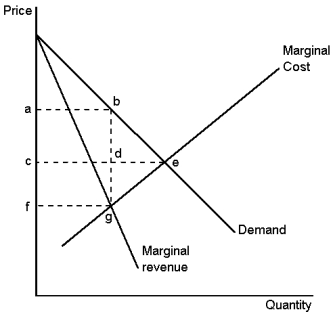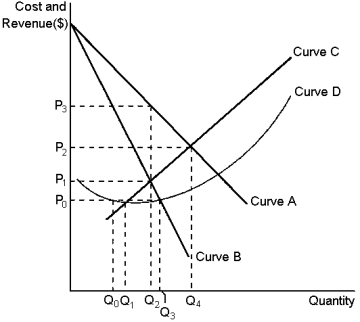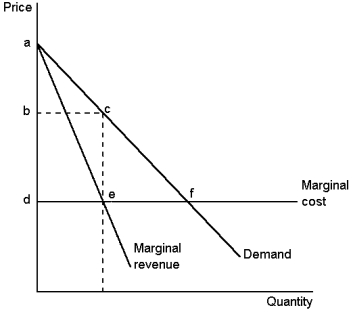Correct Answer

verified
Correct Answer
verified
Multiple Choice
Given a monopolist is the sole producer in a market, it is able to change the price of its product: (i) without affecting the quantity sold (ii) by adjusting the quantity it supplies to the market (iii) but its profit could increase or decrease as a result
A) (ii) only is true
B) (i) and (ii) are true
C) (ii) and (iii) are true
D) (i) and (iii) are true
Correct Answer

verified
Correct Answer
verified
Multiple Choice
Table 15-1 -Refer to Table 15-1.If the monopolist sells eight units of its product, how much revenue will it receive from the sale?
A) 5
B) 26
C) 208
D) not enough information is given to answer this question
Correct Answer

verified
Correct Answer
verified
Multiple Choice
If a monopolist faces a downward-sloping market demand curve, its:
A) average revenue is always less than marginal revenue
B) marginal revenue is greater than the price of the units it sells
C) marginal revenue is always less than the price of the units it sells
D) average revenue is less than the price of its product
Correct Answer

verified
Correct Answer
verified
Multiple Choice
Graph 15-5  This graph depicts the demand, marginal-revenue and marginal-cost curves of a profit-maximising monopolist.Use the graph to answer the following question(s) .
-Refer to Graph 15-5.Compared to the monopoly outcome, an economy designed by a social planner would have a total surplus greater by an amount equal to:
This graph depicts the demand, marginal-revenue and marginal-cost curves of a profit-maximising monopolist.Use the graph to answer the following question(s) .
-Refer to Graph 15-5.Compared to the monopoly outcome, an economy designed by a social planner would have a total surplus greater by an amount equal to:
A) rectangle ACDB
B) rectangle CFGD
C) triangle BDE
D) triangle BGE
Correct Answer

verified
Correct Answer
verified
True/False
Monopolies are inefficient because at the profit maximising quantity there will still be consumers whose willingness-to-pay is higher than the product's marginal cost.
Correct Answer

verified
Correct Answer
verified
Multiple Choice
The inefficiency of a deadweight loss stems from the fact that:
A) consumers buy fewer units when the monopoly firm raises its price
B) high monopoly prices take money from consumers' pockets and put it in the pocket of the monopoly owners
C) consumers who still buy the product at the high price are worse off
D) all of the above are true
Correct Answer

verified
Correct Answer
verified
Multiple Choice
Which of the following statements are true? i. in a monopoly, average revenue always equals the price of the good ii. a monopoly's profit is maximised when price equals marginal revenue iii. the marginal revenue curve will always lie below the demand curve
A) (i) and (ii) only
B) (i) and (iii) only
C) (ii) and (iii) only
D) (i) , (ii) , and (iii)
Correct Answer

verified
Correct Answer
verified
Multiple Choice
Suppose that Dave's Camera Shop operates in a competitive market for cameras, which of the following statements is (are) true? (i) he can maximise profit by raising his prices (ii) he can maximise profit by altering the quantity of cameras that he supplies (iii) he will be able to earn a profit only if he differentiates his cameras from the rest of the market
A) (i) only
B) (ii) only
C) (i) and (ii)
D) (iii) only
Correct Answer

verified
Correct Answer
verified
True/False
A monopoly firm has an upward-sloping supply curve.
Correct Answer

verified
Correct Answer
verified
Multiple Choice
Graph 15-2  This graph reflects the cost and revenue structure for a monopoly firm.Use the graph to answer the following question(s) .
-Refer to Graph 15-2.The number of consumers who did not buy the good despite a willingness-to-pay greater than marginal cost is given by:
This graph reflects the cost and revenue structure for a monopoly firm.Use the graph to answer the following question(s) .
-Refer to Graph 15-2.The number of consumers who did not buy the good despite a willingness-to-pay greater than marginal cost is given by:
A) Q₂ - q₀
B) Q₃ - Q₁
C) Q₄ - Q₁
D) Q₄ - Q₂
Correct Answer

verified
Correct Answer
verified
Multiple Choice
Graph 15-6  This graph depicts the demand, marginal-revenue and marginal-cost curves of a profit-maximising monopolist.Use the graph to answer the following question(s) .
-Refer to Graph 15-6.What is the deadweight loss equal to when the monopolist does NOT price discriminate?
This graph depicts the demand, marginal-revenue and marginal-cost curves of a profit-maximising monopolist.Use the graph to answer the following question(s) .
-Refer to Graph 15-6.What is the deadweight loss equal to when the monopolist does NOT price discriminate?
A) ABC
B) ADF
C) CEF
D) deadweight loss will equal zero
Correct Answer

verified
Correct Answer
verified
Multiple Choice
Identify the true statements about economic wellbeing from the following list.Economic wellbeing is: (i) the sum of consumer surplus and producer surplus (ii) marginal revenue to the producer minus the average cost to the consumer (iii) total profit of producers
A) (i) and (ii)
B) (ii) and (iii)
C) (i) and (iii)
D) (i) only
Correct Answer

verified
Correct Answer
verified
Multiple Choice
Total economic loss due to monopoly pricing is equal to:
A) the deadweight loss
B) the loss to consumer and producer surplus combined
C) the loss to total surplus
D) all of the above
Correct Answer

verified
Correct Answer
verified
Multiple Choice
In which of the following situations will a firm be unable to price discriminate?
A) when different groups of consumers can be separated based on an observable characteristic
B) when consumers can communicate price information, but are unable to trade
C) when there are large differences in the willingness to pay of different consumers
D) when trading of the good is possible between consumers
Correct Answer

verified
Correct Answer
verified
Multiple Choice
Graph 15-6  This graph depicts the demand, marginal-revenue and marginal-cost curves of a profit-maximising monopolist.Use the graph to answer the following question(s) .
-Refer to Graph 15-6.If the monopoly firm perfectly price discriminates, what will the consumer surplus be?
This graph depicts the demand, marginal-revenue and marginal-cost curves of a profit-maximising monopolist.Use the graph to answer the following question(s) .
-Refer to Graph 15-6.If the monopoly firm perfectly price discriminates, what will the consumer surplus be?
A) ABC
B) ADF
C) CEF
D) consumer surplus will equal zero
Correct Answer

verified
Correct Answer
verified
Multiple Choice
Monopoly pricing prevents some mutually beneficial trades from taking place.These unrealised mutually beneficial trades are:
A) a deadweight loss to society
B) a sunk cost to society
C) of little concern to society because no money was lost
D) not considered a cost because they never happened
Correct Answer

verified
Correct Answer
verified
Multiple Choice
The main constraint facing the ability of a natural monopolist to price its product is:
A) its labour costs
B) the regulations imposed by the government
C) nothing - there are no constraints on the price as the monopolist has all the power
D) the market demand curve
Correct Answer

verified
Correct Answer
verified
True/False
Total economic loss due to monopoly pricing is equal to the loss to producer surplus minus the loss in consumer surplus.
Correct Answer

verified
Correct Answer
verified
Multiple Choice
A profit-maximising monopolist will choose a level of output at where:
A) marginal revenue equals the price
B) average revenue is equal to average total cost
C) marginal revenue is equal to marginal cost
D) average total cost is at a minimum
Correct Answer

verified
Correct Answer
verified
Showing 141 - 160 of 212
Related Exams